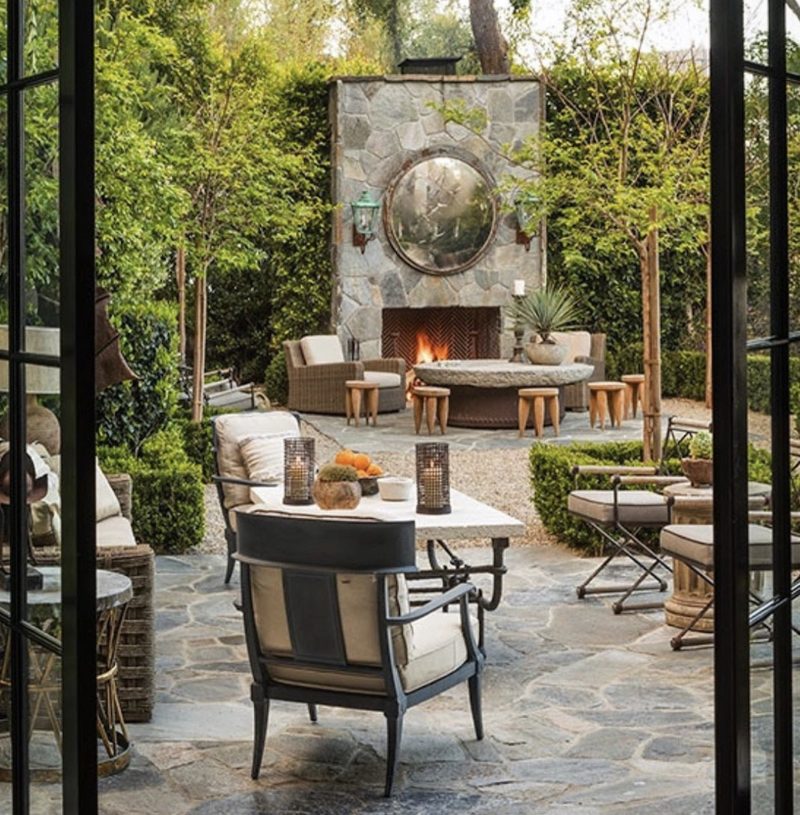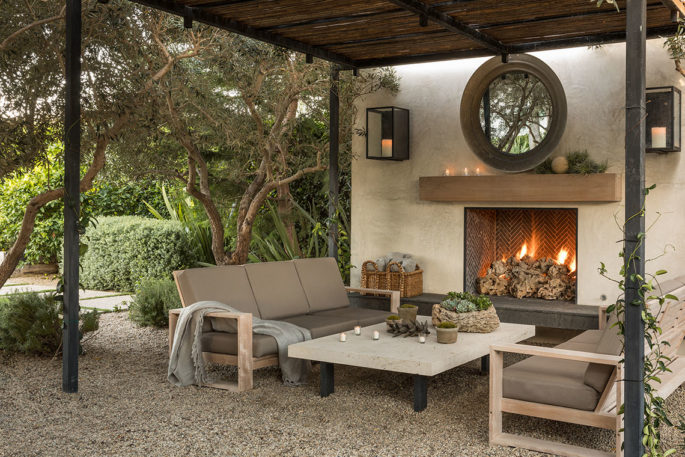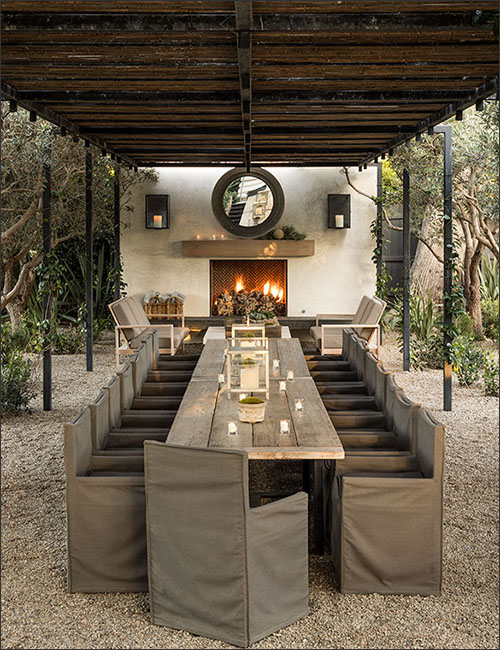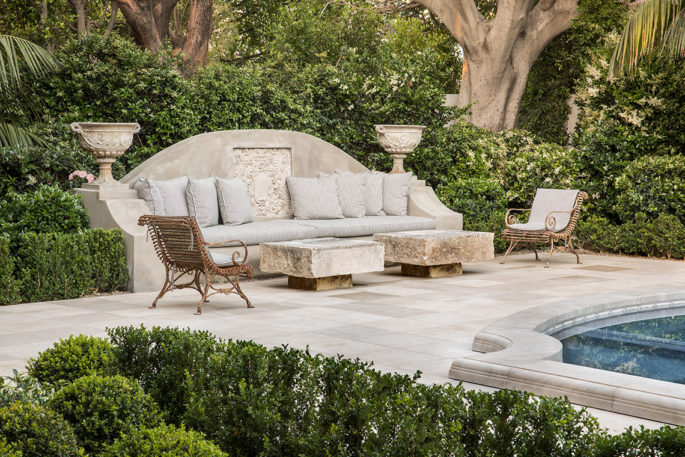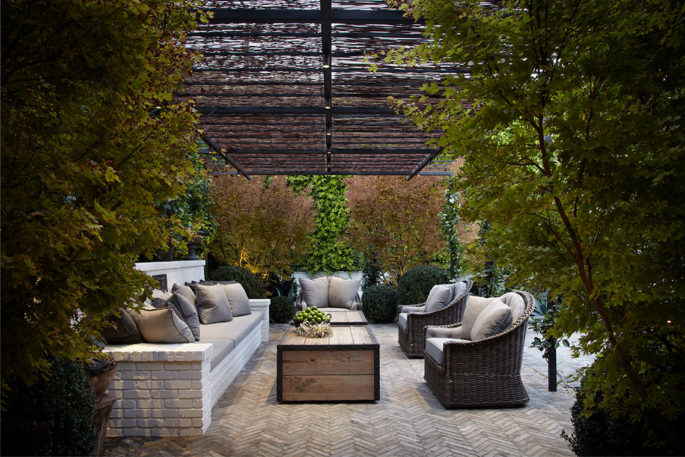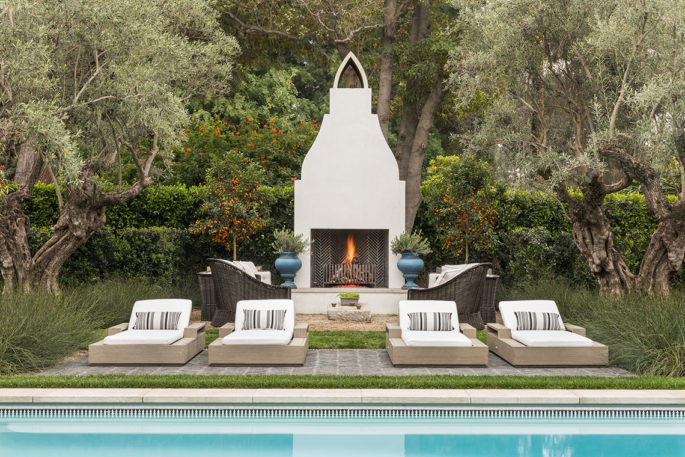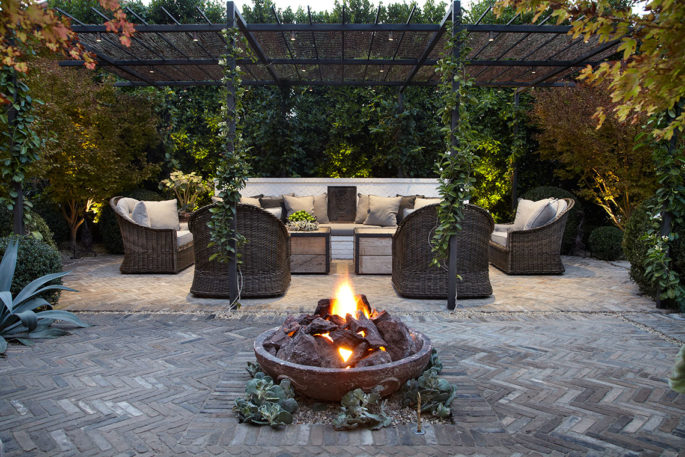If you are fortunate enough to have a terrace, a porch or some outdoor space, spending a lot of time at home can be a much nicer experience.
But how you design that space makes all the difference.

Choose your function: Start with an honest assessment of how you plan to use the space. such as The Hillside garden, by Scott Shrader, scottshrader.com
“A lot of times, you’ll see a beautiful garden with very organized furniture, which looks pretty, but when you actually go and sit, it’s out in the blazing sun,” says our pal Scott Shrader, a leading landscape designer in West Hollywood, California, and the author of great book, “The Art of Outdoor Living.” Read more, ‘Making A Modern Garden.’
If you want an outdoor space where you’ll be comfortable lingering for hours, he said, you need to address some basic questions: “Can you be protected from the sun? Can you put a drink down? Can you put your feet up?”
In short, you need to think of it as another room in your home — an outdoor room — and furnish it accordingly.
Choose Your Function
An outdoor room won’t serve any function particularly well if it tries to do everything, so start with an honest assessment of how you plan to use the space. “You want to ask yourself, first and foremost, ‘What are we going do there?’” said Charlotte Moss, a New York-based designer and a passionate gardener. Read more, ‘How To Improve Your Outdoor Space.’
If the terrace will be a place for alfresco dining, you’ll need chairs that will allow people to sit upright and a table high enough to eat at — a very different arrangement of furniture than a space for casual lounging, where sofas and low tables may be more appropriate. “Or maybe it’s just a space for hiding from everyone,” Ms. Moss said, which would require greater privacy and perhaps just a single chaise longue. Read more, ‘Landscaping Don’ts: 10 Design Mistakes To Avoid.’
If your outdoor space is large, planning several different seating arrangements can accommodate multiple functions.
Tie It to the Indoors
When you’re trying to decide on the style of an outdoor room, look to your home’s interior-design scheme, Shrader said, to reinforce the connection between indoors and out. “I always start inside the house and work my way out,” he said, with the goal of achieving “an effortless flow from inside to outside.” Read more, ‘The 25 Rooms That Influence The Way We Design.’
In his West Hollywood home which I’ve been fortunate enough to visit, he said, the indoor floors are antiqued oak, so he installed chiselled stone pavers on the terrace outside, for a similar sense of age.
“I try to blend the materials and make them all uniform so that you don’t have anything super jarring, and it’s all very harmonious,” he said. Your interior-design scheme can also inform material and color choices for outdoor furniture, accessories and even plantings, said Keith Williams, a partner at the Palm Beach-based landscape-architecture firm Nievera Williams and the author of “The Graphic Garden.” For instance, he said, “if the house has soft, pale colours, we’ll tend to pick that up in the landscaping” through the choice of outdoor fabrics and flowers.
Create a Floor
Demarcate the area of the outdoor room — and make it feel like a destination that stands apart from the rest of the terrace or yard — by changing the flooring material where the furniture will be placed. For an outdoor dining table by a pool in Palm Beach, for instance, Williams designed an area where the ground looks almost like carpet, with crisscrossing lines of black pebbles and diamond-shaped patches of synthetic grass. Read more, ‘Everything You Need To Know About Outdoor Flooring.’
Wesley Moon, a New York-based interior designer, rolled out an actual carpet at his apartment on Fire Island — an indoor-outdoor rug from Dash & Albert. “It gives that softness that really makes it feel like a room,” he said, noting that it is surprisingly easy to keep clean. “You just vacuum it like a normal rug.” A section of wood decking could also be used to underpin a seating area, Mr. Moon noted, within a large expanse of pavers. Moss, inspired by the gardens at Colonial Williamsburg, in Virginia, used crushed oyster shells for the floor of the outdoor dining area in her garden in East Hampton, N.Y. Shrader sometimes uses an area of pea gravel.
Add a Ceiling and Walls
If there is no roof or overhang above your outdoor space, you can at least create the impression of a ceiling, Shrader said, both for the intimacy a sense of enclosure provides and for protection from the sun. “Everybody feels most comfortable when they’re tucked under something,” he said. Putting a seating area beneath the canopy of a tree is one of his favourite techniques.
“Often, I talk about trees as my outdoor ceilings,” he said.
In the absence of a tree, Shrader will sometimes add a trellis over a seating arrangement, which he might cover with willow or bamboo.
An umbrella would also work, he said, although it won’t be as sturdy or durable. It’s also possible to add a sense of privacy by introducing tall plantings around the perimeter of an outdoor room. “It’s not a physical wall, but more of a visual separation that says, ‘Something is happening here,’’ Moss said. “It could even be a 3-foot hedge that defines the space.” For her dining space in East Hampton, Moss installed a ceiling of hickory branches above walls of clipped hornbeams. On a terrace or balcony, tall planters filled with leafy or flowering plants could be used to similar effect.
Furnish as You Would Indoors
Many successful outdoor rooms have nearly as much furniture, and as many accessories, as indoor rooms. “I try really hard to make the outdoors just as comfortable and chic as the indoors,” Moon said, “so people really want to spend time out there.” Read more, ‘6 Outdoor Furniture Trends of 2020- For Any Budget.’
That means plenty of comfortable seating, often with cushions upholstered in outdoor fabric (typically solution-dyed acrylic for durability). It also means having enough tables to hold drinks, snacks, phones and books. Add outdoor throw pillows in the same way you would use indoor pillows in the living room, Moon said, and keep throws handy for cool evenings. In an outdoor room on a Manhattan terrace, Moon used low-slung, armless chairs from Dedon with throw pillows in various shapes, sizes and fabrics, as well as a group of small teak-and-stone tables that could be pushed together as a coffee table or pulled apart as side tables.
If your outdoor room will serve as a dining space, Shrader said, “You really need to think about it like you’re in an indoor dining room and hosting Thanksgiving dinner.” Consider the maximum number of guests you’re likely to entertain and make sure you have an appropriately sized table and enough chairs, he advised. Then think about how you will serve meals. A strategically placed buffet or console table can hold platters during dinners or function as a bar for cocktail parties, he said. After guests leave, that same piece of furniture can serve as a pedestal for potted plants and decorative objects.
Illuminate the Space
Lighting is an important functional consideration — without it, you might not be able to find your drink after dark — but it can also provide a significant boost to nighttime ambience. Some methods of adding light are simpler than others. “You can hang a candle chandelier from a tree branch or have lanterns with candles,” Moss said. “It’s very romantic.” Plug-in string lights and portable LED-based candles and lanterns are other easy options for adding light that don’t require hiring an electrician. Read more, ‘Get Switched On: The Latest In Outdoor Lighting.’
This is an excerpt of an article that first appeared in The New York Times.

